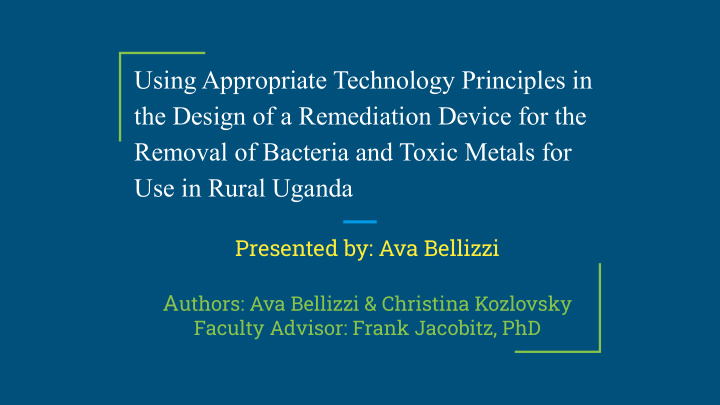



Using Appropriate Technology Principles in the Design of a Remediation Device for the Removal of Bacteria and Toxic Metals for Use in Rural Uganda Presented by: Ava Bellizzi A uthors: Ava Bellizzi & Christina Kozlovsky Faculty Advisor: Frank Jacobitz, PhD
Introduction ● 2.2 billion people worldwide lack access to “safely managed” drinking water (World Health Organization, 2019). ● Only 7% of the population of Uganda utilized safely managed drinking water services as of 2017 (UNICEF, 2019). ● 80% of the population of Uganda lives in rural areas (Nayebare et al., 2014). ○ Poorest water quality due to reliance on groundwater and surface water sources (Nayebare et al., 2014).
What is Appropriate Technology? A“ strategy ” for the developing world to achieve socioeconomic growth by “ meeting their basic needs ” through “ developing their own skills ” and utilizing “ available resources in an environmentally sustainable manner ” (Murphy et al., 2009). “ Technology with a human face , which, instead of making human hands and brains redundant, helps them to become far more productive than they ever had before ” (Schumacher, 1973 , p. 112 )
Technical Project Overview Quality Drinking Water Collect water from Bind and remove toxic metals Trap and eliminate Obtain safe drinking local source using a banana peel and bacteria using eucalyptus water activated carbon tea bag tree xylem 1.
Methods Assessment of the following appropriate technology considerations as they ● relate to the engineering design process (Sianipar et al., 2013a ) : ○ Technical Economic ○ Environmental ○ ○ Socio-Cultural Evaluation of the extent to which the device encourages: ● Sustainable development ○ ○ “Community empowerment” (Sianipar et al., 2013b)
Results: Technical Banana-activated carbon tea bag capable of reducing concentration of ● manganese * ( M. Klein, personal communication, September 23, 2019). Eucalyptus xylem is capable of removing all fecal coliforms ● Confirmed through testing conducted in Uganda ** (C. Kozlovsky, personal ○ communication, January 29, 2020). Uganda results validated through testing conducted through ○ partnership with Azrieli College of Engineering Jerusalem *** (A. Shasha, personal communication, March 11, 2020). System can be used and maintained at household level ● * Testing conducted by Molly Klein (Biochemistry) ** Testing conducted by Christina Kozlovsky (Mechanical Engineering) *** Testing conducted by Ariel Shasha and Liron Kanisberg (Mechanical Engineering)
Results: Economic Goal for final design: $1.50/month per family ● ● Cost of prototype: $27 total ○ Durable and reusable PVC pipe can last 25-40 years ■ (Smith’s Plumbing Services, 2019) ● Cost of prototype machined parts only: $8 total ○ If replaced every 6 months, $1.33/month Utilizes local materials ● Can engage local talent for manufacturing ● 1.
Results: Environmental Utilizes readily available materials ● ○ Banana peels 2. ○ Eucalyptus tree branches No use of electrical power ● Reusable device ● ● Minimal waste generation 3.
Results: Socio-Cultural Integration with daily routine ● ● Locally available materials ● Minimal education required for use and maintenance Acceptable for use by all ● Women ○ ○ Children
Discussion: Sustainable Development & Community Empowerment A“ strategy ” for the developing world to achieve socioeconomic growth by “ meeting their basic needs ”
Discussion: Sustainable Development & Community Empowerment through “ developing their own skills ” and utilizing “ available resources in an environmentally sustainable manner ” (Murphy et al., 2009). Sustainable Development ● Social Learning (Murphy et al., 2009) ● Ongoing partnership (Amadei et al., 2009) ● Local manufacturing
Discussion: Sustainable Development & Community Empowerment “ Technology with a human face , which,...helps them to become far more productive than they ever had before ” (Schumacher, 1973 , p. 112 ) Community Empowerment Local responsibility for design, production, and ideation ● (Sianipar et al., 2013b)
Future Directions Ensure sustainable development ● ○ Mechanisms of social learning Strengthening of partnerships ○ ○ Scope of local manufacturing Encourage community empowerment ● ○ Potential for local businesses ○ Economic-social-political cohesion Conduct user testing (long-term) ● ● Begin community implementation (long-term)
Thank you! Questions?
References Amadei, B., & Wallace, W. A. (2009). Engineering for Humanitarian Development: A Socio-technical Approach. IEEE Technology and Society Magazine. Murphy, H.M., McBean, E.A., & Farahbakhsh, K. (2009). Appropriate technology—A comprehensive approach for water and sanitation in the developing world. Technology in Society, 31 (2), 158-167. https://doi.org/10.1016/j.techsoc.2009.03.010 Nayebare, S.R., Wilson, L.R., Carpenter, D.O., Dziewulski, D.M., & Kannan, K. (2014). A review of potable water accessibility and sustainability issues in developing countries-Case study of Uganda. Reviews on Environmental Health, 29 (4): 363-78 . doi:10.1515/reveh-2013-0019 Schumacher, E. F. (1973). Small is Beautiful - a Study of Economics as if People Mattered . London, UK: Blond & Briggs Sianipar, C. P . M., Dowaki, K., Yudoko, G., & Adhiutama, A. (2013). Seven Pillars of Survivability: Appropriate Technology with a Human Face. European Journal of Sustainable Development. https://doi.org/10.14207/ejsd.2013.v2n4p1 Sianipar, C. P . M., Yudoko, G., Adhiutama, A., & Dowaki, K. (2013). Community Empowerment through Appropriate Technology: Sustaining the Sustainable Development. Procedia Environmental Sciences. https://doi.org/10.1016/j.proenv.2013.02.120 Smith’s Plumbing Services. (2019, Nov. 19). How Long Will My Pipes Last? https://www.smithsplumbingservice.com/blog/2019/november/how-long-will-my-pipes-last-/ UNICEF. (2019, Jun.) Drinking water. https://data.unicef.org/topic/water-and-sanitation/drinking-water/ World Health Organization. (2019, Jun. 14). Drinking-water. https://www.who.int/news-room/fact-sheets/detail/drinking-water
Image References 1. Bellizzi, A.M. & Kozlovsky, C.N. (2020, Mar. 26). Uganda Water Filtration System: Critical Design Review [Capstone Senior Design course presentation]. Critical Design Review, University of San Diego, San Diego, CA, United States. 2. Eucalyptus tree [Photograph].(2005). Wikimedia Commons. https://commons.wikimedia.org/wiki/File:Eucalyptus_tree.jpg 3. Banane-A-05 cropped [Photograph](2013). Wikimedia Commons. https://commons.wikimedia.org/wiki/File:Banane-A-05_cropped.jpg
Recommend
More recommend